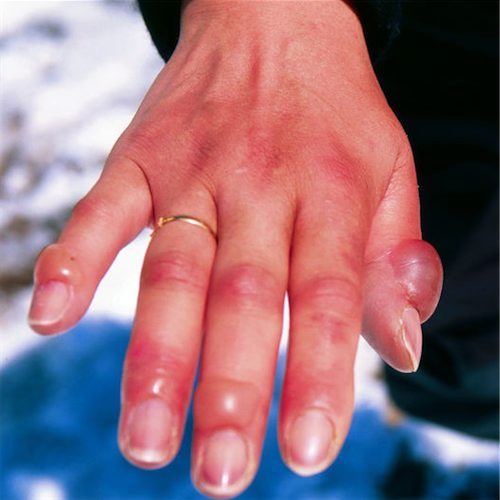|
Frostbite
 First, call for
help. First, call for
help.
Keep the affected
part elevated in order to reduce swelling
Move to a warm area
to prevent further heat loss.
Note that many people
with frostbite may be experiencing hypothermia. Saving their lives is more
important than preserving a finger or foot.
Remove all
constrictive jewelry and clothes because they may further block blood flow.
Give the person warm,
nonalcoholic, non-caffeinated fluids to drink.
Apply a dry, sterile
bandage, place cotton between any involved fingers or toes (to prevent
rubbing), and take the person to a medical facility as soon as possible.
Never re-warm an
affected area if there is any chance it may freeze again. This thaw-refreeze
cycle is very harmful and leads to disastrous results.
Also, avoid a gradual
thaw either in the field or in the transport vehicle. The most effective
method is to re-warm the area quickly. Therefore, keep the injured part away
from sources of heat until you arrive at a treatment facility where proper
re-warming can take place. Do not rub the frozen
area with snow (or anything else, for that matter). The friction created by
this technique will only cause further tissue damage.
Above all, keep in
mind that the final amount of tissue destruction is proportional to the time
it remains frozen, not to the absolute temperature to which it was exposed.
Therefore, rapid transport to a hospital is very important.Medical Treatment
- After initial life
threats are excluded, re-warming is the highest priority.
- This is
accomplished rapidly in a water bath heated to 40-42°C (104-107.6°F) and
continued until the thaw is complete (usually 15-30 minutes).
- Narcotic pain
medications may be given because this process is very painful.
- Because dehydration
is very common, intravenous fluids may also be given.
- After re-warming,
post-thaw care is undertaken in order to prevent infection and a continuing
lack of oxygen to the area.
- The clear blisters
are removed while the bloody ones are left intact so as not to disturb the
underlying blood vessels.
- A tetanus booster
is given if needed.
- People with frostbite
are hospitalized for at least 1-2 days to determine the extent of injury and
to receive further treatment.
- Aloe Vera cream is
applied every 6 hours, and the area is elevated and splinted.
- Ibuprofen is given
twice per day to combat inflammation and penicillin or another appropriate
antibiotic given to prevent infection.
- For deep frostbite,
daily water therapy in a 40°C (104°F) whirlpool bath will be performed in
order to remove any dead tissue.
- A number of
experimental therapies do exist, many of which aim to further treat the
inflammation or decreased blood flow seen in frostbite. As of yet, none of
these treatments has proven beneficial.
-
First Aid Case List -
back to top - |
 First, call for
help.
First, call for
help.